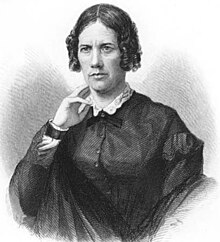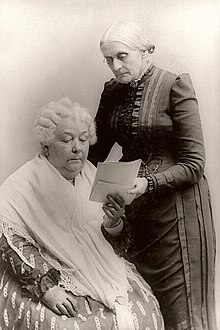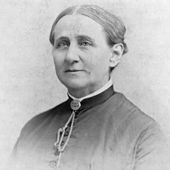National Women's Rights Convention
Contents[show] |
[edit] Background
Signers of the Declaration of Sentiments hoped for "a series of Conventions, embracing every part of the country" to follow their own meeting. Because of the fame and drawing power of Lucretia Mott, who wouldn't be visiting the Upstate New York area for much longer, a regional Woman's Rights Convention was held two weeks later in Rochester, New York with Mott as featured speaker. In the next two years, "the infancy of the movement", local and state women's rights conventions were called in Ohio, Indiana, and Pennsylvania.[2]
[edit] Planning

Prior to leaving for Illinois, Stone asked Davis to carry the full burden of planning the convention. Davis sent letters to prominent liberal thinkers such as Elizabeth Cady Stanton, who sent her regrets along with a letter of support and a speech to be read in her name. Stanton wished to stay at home because she would be in the late stages of pregnancy.[6]
[edit] 1850 in Worcester
At the convention, some 900 showed up for the first session, men forming the majority, with several newspapers reporting over a thousand attendees by the afternoon of the first day,[6] and more turned away outside.[5] Delegates came from eleven states, including one delegate from California – a state only a few weeks old.[7]| “ | We want to be something more than the appendages of Society; we want that Woman should be the coequal and help-meet of Man in all the interest and perils and enjoyments of human life. We want that she should attain to the development of her nature and womanhood; we want that when she dies, it may not be written on her gravestone that she was the "relict" of somebody.[8] | ” |
Stone paid to have the proceedings of the convention printed as booklets; she would repeat this practice after each of the next six annual conventions. The booklets were sold at her lectures and at subsequent conventions[8] as Woman's Rights Tracts.[11]
In England, a copy of the Tribune article inspired Harriet Taylor to write The Enfranchisement of Women.[12] Harriet Martineau wrote a letter to Davis in August 1851 to thank her for sending a copy of the proceedings, and mentioned seeing in a radical English quarterly The Enfranchisement of Women authored by, she thought, John Stuart Mill. Martineau wrote "I hope you are aware of the interest excited in this country by that Convention, the strongest proof of which is the appearance of an article on the subject in the The Westminster Review ...I am not without hope that this article will materially strengthen your hands, and I am sure it can not but cheer your hearts."[13]
[edit] 1851 in Worcester
A second national convention was held October 15–16, 1851, again in Brinley Hall, with Paulina Kellogg Wright Davis presiding. Harriet Kezia Hunt and Antoinette Brown gave speeches, while a letter from Elizabeth Cady Stanton was read. Lucretia Mott served as an officer of the meeting.[2]| “ | Throw open the doors of Congress; throw open those court-houses; throw wide open the doors of your colleges, and give to the sisters of the De Staëls and the Martineaus the same opportunity for culture that men have, and let the results prove what their capacity and intellect really are. When woman has enjoyed for as many centuries as we have the aid of books, the discipline of life, and the stimulus of fame, it will be time to begin the discussion of these questions: "What is the intellect of woman?" "Is it equal to that of man?"[14] | ” |
Abby Kelley Foster gave testimony to the persecution she had suffered as a woman: "My life has been my speech. For fourteen years I have advocated this cause by my daily life. Bloody feet, sisters, have worn smooth the path by which you have come hither."[16] Abby H. Price spoke about prostitution, as she had the year before, arguing that too many women fell to prostitution because they did not have the job opportunities or education that men had.[16]
A letter was read from two imprisoned French feminists, Pauline Roland and Jeanne Deroin, saying "Your courageous declaration of Woman's Rights has resounded even to our prison, and has filled our souls with inexpressible joy."[17]
Ernestine Rose gave a speech about loss of identity in marriage that Davis later characterized as "unsurpassed". Rose said of woman that "At marriage she loses her entire identity, and her being is said to have become merged in her husband. Has nature thus merged it? Has she ceased to exist and feel pleasure and pain? When she violates the laws of her being, does her husband pay the penalty? When she breaks the moral law does he suffer the punishment? When he satisfies his wants, is it enough to satisfy her nature?...What an inconsistency that from the moment she enters the compact in which she assumes the high responsibility of wife and mother, she ceases legally to exist and becomes a purely submissive being. Blind submission in women is considered a virtue, while submission to wrong is itself wrong, and resistance to wrong is virtue alike in women as in man."[17]
[edit] 1852 in Syracuse
Reverend Lydia Ann Jenkins of Geneva, New York spoke at the convention and asked, "Is there any law to prevent women voting in this State? The Constitution says 'white male citizens' may vote, but does not say that white female citizens may not."[26] The next year, Jenkins was chosen member of the committee tasked with framing the issue of suffrage before the New York Legislature.[27]
A motion was made to form a national organization for women, but after animated discussion, no consensus was reached. Elizabeth Smith Miller suggested the women form organizations at the state level, but even this milder suggestion met with opposition. Paulina Kellogg Wright Davis said "I hate organizations... they cramp me."[28] Lucretia Mott concurred, saying "the seeds of dissolution be less likely to be sown." Angelina Grimké Weld, Thomas M'Clintock and Wendell Phillips agreed, with Phillips saying "you will develop divisions among yourselves."[28] No national organization was to form until after the Civil War.[28]
[edit] 1853 in Cleveland
At Melodean Hall in Cleveland, Ohio, on October 6–8, 1853, William Lloyd Garrison spoke to say "...the Declaration of Independence as put forth at Seneca Falls....was measuring the people of this country by their own standard. It was taking their own words and applying their own principles to women, as they have been applied to men."[2]
Frances Dana Barker Gage served as president for the 1,500 participants. Lucretia Mott, Amy Post, and Martha Coffin Wright served as officers; James Mott served on the business committee, and Lucretia Mott called the meeting to order.[2]
In a letter read aloud, William Henry Channing suggested that the convention issue its own Declaration of Women's Rights and petitions to state legislatures seeking woman suffrage, equal inheritance rights, equal guardianship laws, divorce for wives of alcoholics, tax exemptions for women until given the right to vote, and right to trial before a jury of female peers. Lucretia Mott moved the adoption of the Seneca Falls Declaration of Sentiments, which was read to the convention, debated, then referred to a committee to draft a new declaration. Antoinette Brown, William Lloyd Garrison, Lucretia Mott, Ernestine Rose and Lucy Stone worked to shape a new declaration, and the result was read at the end of the meeting, but was never adopted.[2]
The Plain Dealer printed an extensive account of the convention, opining of Ernestine Rose that she "is the master-spirit of the Convention. She is described as a Polish lady of great beauty, being known in this country as an earnest advocate of human liberty."[30] After commenting on the bloomer costume worn by Lucy Stone, The Plain Dealer continued: "Miss Stone must be set down as a lady of no common abilities, and of uncommon energy in the pursuit of a cherished idea. She is a marked favorite in the Conventions."[30]
[edit] 1854 in Philadelphia
Susan B. Anthony spoke to urge attendees to petition their state legislatures for laws giving women equal rights. A committee was formed to publish tracts and to place articles in national newspapers. Once again, the convention could not agree on a motion to create a national organization, resolving instead to continue work at the local level with coordination provided by a committee chaired by Paulina Kellogg Wright Davis.[2]
Henry Grew took the speaker's platform to condemn women who demanded equal rights. He described examples from the Bible which assigned to women a subordinate role. Lucretia Mott flared up and debated him, saying that he was selectively using the Bible to put upon women a sense of order that originated in man's mind. She said "The pulpit has been prostituted, the Bible has been ill-used... Instead of taking the truths of the Bible in corroboration of the right, the practice has been to turn over its pages to find examples and authority for the wrong."[28] Mott cited Bible passages that proved Grew wrong. William Lloyd Garrison stood up to halt the debate, saying that nearly everyone present agreed that all were equal in the eyes of God.[33]
[edit] 1855 in Cincinnati
Antoinette Brown, Ernestine Rose, Josephine Sophia White Griffing[34] and Frances Dana Barker Gage spoke to the crowd, listing for them the achievements and progress made thus far.[2] Lucy Stone spoke for the right of each person to establish for themselves which sphere, domestic or public, they should be active in.[33] A heckler interrupted the proceedings, calling female speakers "a few disappointed women."[16] Stone responded with a retort that became widely quoted, saying that yes, she was indeed a "disappointed woman." "...In education, in marriage, in religion, in everything, disappointment is the lot of woman. It shall be the business of my life to deepen this disappointment in every woman's heart until she bows down to it no longer."[16]
[edit] 1856 in New York
A letter was read aloud from Antoinette Brown Blackwell: "Would it not be wholly appropriate, then, for this National Convention to demand the right of suffrage for her from the Legislature of each State in the Nation? We can not petition the General Government on this point. Allow me, therefore, respectfully to suggest the propriety of appointing a committee, which shall be instructed to prepare a memorial adapted to the circumstances of each legislative body; and demanding of each, in the name of this Convention, the elective franchise for woman."[35] A motion was passed approving of the suggestion, and Wendell Phillips recommended that women in each state be contacted and encouraged to take the memorial petition to their respective legislative bodies.[35]
[edit] 1858 in New York
Frederick Douglass took the stage to speak after repeated calls from the audience. Lucy Stone, Reverend Antoinette Brown Blackwell (now married to Samuel Charles Blackwell), Reverend Thomas Wentworth Higginson and Lucretia Mott were among those that spoke.[2] Stephen Pearl Andrews startled the assemblage by advocating free love and unconventional approaches to marriage. He hinted at birth control by insisting that women should have the right to put a limit on "the cares and sufferings of maternity."[16] Eliza Farnham presented her view that women were superior to men, a concept that was hotly debated. The convention, marred by interruption and rowdyism, "adjourned amid great confusion."[2]
[edit] 1859 in New York
Held again at Mozart Hall in New York City on May 12, 1859, the ninth national convention opened with Lucretia Mott presiding. Caroline Wells Healey Dall read out the resolutions including one intended to be sent to every state legislature, urging that body to "secure to women all those rights and privileges and immunities which in equity belong to every citizen of a republic."[2]Another unruly crowd made it difficult to hear the speeches of Antoinette Brown Blackwell, Caroline Dall, Lucretia Mott and Ernestine Rose. Wendell Phillips stood to speak and "held that mocking crowd in the hollow of his hand."[2]
[edit] 1860 in New York
At the Cooper Union in New York City on May 10–11, 1860, the tenth national convention of 600–800 attendees was presided over by Martha Coffin Wright. A recent legislative victory in New York was praised, one which gave women joint custody of their children and sole use of their personal property and wages.[2]
Horace Greeley wrote in the Tribune that there were "One Thousand Persons Present, seven-eighths of them Women, and a fair Proportion Young and Good-looking."[36] Greeley, a foe of marriage reform, continued against Stanton's proposed resolution with a jab at "easy Divorce", writing that the word 'Woman' should be replaced in the convention's title with "Wives Discontented."[36]
[edit] Civil War and beyond
The coming of the American Civil War ended the annual National Women's Rights Convention and focused women's activism on the issue of emancipation for slaves. The New York state legislature repealed in 1862 much of the gain women had made in 1860. Susan B. Anthony was "sick at heart" but could not convince women activists to hold another convention focusing solely on women's rights.[2]In 1863, Elizabeth Cady Stanton, recently moved to New York City, joined with Susan B. Anthony to send a call out, via the woman's central committee chaired by Paulina Kellogg Wright Davis, to all the "Loyal Women of the Nation" to meet again in convention in May. Forming the Woman's National Loyal League were Stanton, Anthony, Martha Coffin Wright, Amy Post, Antoinette Brown Blackwell, Ernestine Rose, Angelina Grimké Weld, and Lucy Stone, among others. They organized the First Woman's National Loyal League Convention at the Church of the Puritans in New York City on May 14, 1863, and worked to gain 400,000 signatures by 1864 to petition the United States Congress to pass the Thirteenth Amendment abolishing slavery.[2]
[edit] 1866 in New York
On May 10, 1866, the Eleventh National Woman's Rights Convention was held at Church of the Puritans, Union Square. Called by Stanton and Anthony and sponsored by the National Woman Suffrage Association, the meeting included Ernestine L. Rose, Wendell Phillips, Reverend John T. Sargent, Reverend Octavius Brooks Frothingham, Frances D. Gage, Elizabeth Brown Blackwell,[37] Theodore Tilton, Lucretia Mott, Martha C. Wright, Stephen Symonds Foster and Abbey Kelley Foster, Margaret Winchester and Parker Pillsbury, and was presided over by Stanton.[38]A stirring speech against racial discrimination was given by African-American activist Frances Ellen Watkins Harper, in which she said "You white women speak here of rights. I speak of wrongs. I, as a colored woman, have had in this country an education which has made me feel as if I were in the situation of Ishmael, my hand against every man, and every man's hand against me."[39]
A few weeks later, on May 31, 1866, the first meeting of the American Equal Rights Association was held in Boston.[40]
[edit] 1869 in Washington, D.C.
An event that was reported as "The twelfth regular National Convention of Women's Rights" was held on January 19, 1869. Prominent speakers included Lucretia Mott, Elizabeth Cady Stanton, Susan B. Anthony, Senator Samuel Clarke Pomeroy, Parker Pillsbury, John Willis Menard and Doctor Sarah H. Hathaway. Doctor Mary Edwards Walker and a "Mrs. Harman" were seen in "male attire" actively passing back and forth between the audience and the stage.[41]Stanton spoke heatedly with a prepared speech against those who had established "an aristocracy of sex on this continent."[42] "If serfdom, peasantry, and slavery have shattered kingdoms, deluged continents with blood, scattered republics like dust before the wind, and rent our own Union asunder, what kind of a government, think you, American statesmen, you can build, with the mothers of the race crouching at your feet...?"[43] Other speeches were off-the-cuff, and little record is known of them.[44]
[edit] See also
- Equal Rights Amendment (ERA)
- Reproductive rights – issues regarding "reproductive freedom"
- Convention on the Elimination of All Forms of Discrimination Against Women (CEDAW)
- Vindication of the Rights of Women
- Women's right to know
- Committee on Women's Rights and Gender Equality
- Subjection of women
- League of Women Voters
- In Defense of Women
- Parental leave
- Feminism
- History of feminism
- First-wave feminism
- List of suffragists and suffragettes








